Tre galna ryssar på Sveriges tak
Alexey Dolinin och två kamrater var i Kebnekaise på äventyr. Läs den spännande berättelsen som är skriven på engelska.
Av: alexey
TRE GALNA RYSSAR PÅ SVERIGES TAK
av Alexey Dolinin
Sunday, March 18th. At 2 p.m.
I'm in Kiruna. My friends, Anton and Michael, drove yesterday from
St.Petersburg, covering the distance in about 17 hours. It's way longer from
Lund - 2000 km vs 1300, so my train journey was a bit longer. The guys are
stationed in the STF hostel and we drive there in Michael's
"Passat". That's probably the only car of the kind in Sweden -
instead of buying a baggage holder for the roof Michael, who owns and runs a
small furniture and carpenting company, screwed 2 thick oak pieces he claims
to be strong enough across the existing bars. Well, it did hold for the 6000
km the journey amounted to in the end…
It's cold and sunny - one can hardly desire better weather for ski-touring.
I feel stunned, having not seen any decent snow and having hardly
experienced any temperatures below zero since… of course summer, when me
and Michael climbed in the Caucasus. Skåne is not exactly the skiers'
paradise, you know…
Anyway, we move to the hostel and spend the rest of the day repacking and
sorting our loads - two weeks' supply of food and gas, and all kinds of
possible climbing gear. Here I need to make an explanation: since I failed
to find any detailed descriptions on the net, it was kind of hard to
estimate what one needs to master, say, Kaskasapakte's east ridge or
traverse of Kebne. So we took all the stuff with us, hoping to sort it out
after consulting with the guides at the mountain station. Indeed, they were
extremely helpful, and also had an own guidebook in Swedish, that was
composed in familiar terms, much more comprehensible then "light
climbing to climbing" one can find in the published book by Tore
Abrahamsson, however useful it might be in the other aspects.
After sneezing our way through several boxes of equipment the guys took out
of my closet in St.Petersburg just before take-off we finally had the
backpacks containing food for a week and the necessary gear ready. The rest
of the food and some personal things are to be left at the mountain station
- that is, we plan to pick up more supplies after we're done with the first
part. The hearty dinner with some red is quite a reward after the
"standard logistic challenge of the start".
Monday, March 19th
A short (compared to…) drive to Nikkaluokta, and we're in the Göran's
fjälltransport scooters, heading towards the mountain station. That's quite
a relief - otherwise we'd have to haul all the stuff for the whole day over
the plain, which doesn't exactly exemplify our concept of vacation and
winter climbing. A chat with the girls at the reception, one last attempt to
deside if something else can be left behind - and we start slowly but
steadily to Tarfala. Anton and I have the randonnee skis with skins bought
second-hand in St.Petersburg just for the occasion. Michael uses Russian
"Beskid" - older randonnee model with the "kind of telemark
binding" he himself constructed and made in his workshop to suit his
climbing "Koflachs". The drawback is he doesn't have the skins, so
the altitude gain is harder for him, despite his obviously better physical
condition (it was this way ever since we started climbing and skiing
together in '90 - he hasn't got any belly since then, which is,
unfortunately, not the case with me).
About halfway to the Tarfala hut I suddenly hear a flood of curses Russian
language is so rich in. Anton's Silvretta binding was surely heavily used
and repaired before - now the heel part is broken exactly where the parts
were welded together after "earlier trauma". We can't fix it
ourselves, so the only choice is to get back to the station and seek help of
the guides. A quarter of an hour skiing for us two and an hour of tiresome
walking for Anton - and we're there. Luckily enough, the guys at
"Sporten" managed to find a spare part for us. We seize the moment
and question them about Kaskasapakte, weather and all possible sorts of
things… It appears we're probably the first Russians to come here -
surprisingly enough, given the region's relative proximity to St.Pete's and
tremendous opportunities for ski-touring. It's virtually the same distance
as to Hibiny Mountains, the Scandinavian ridge' easternmost
"offspring" on the Kola peninsula and the ski-touring Mecca for
Petersburgers. The price of the journey might differ, though…
Tuesday, March 20th
Relatively early in the morning we start again to Tarfala. Three
uneventful hours later we're there and start cooking in the small hut open
for those who travel while the hut is still officially closed. The still and
sunny morning gave way to rather windy afternoon, so there's not much folk
in Tarfala valley, some coming up to the hut and skiing than back to the
mountain station. Some lonely traveller, however, is climbing in the
vicinity - he left a big backpack in the hut.
After an idle lunch we climb up the Kebnepakte pass - to try the skis and
get the feeling back. On our way up we meet Ulf - the guy whose things are
in the hut. He attempted Kaskasapakte via the west face's snowfields, but
had to turn back because of the clouds obscuring the summit. He is a very
courageous man - it's rather risky to attempt such a solo-climb without
detailed descriptions. After we return to the hut, we chat a bit with him -
he plans to descend to the station and attempt the West route to Kebnekaise
next day. Ulf declines a shot of cognac we offer him, probably being a
little shy, and seems to be very surprised that we manage to carry a cognac
flask on top of all the necessary stuff. Well, you can't really take enough
food, so little luxury is a consolation. About 7 in the evening we see a
group of tourists that, Ulf says, started towards Drakryggen in the morning
from the research station about 500 m down the valley. Should this really be
THAT far?
Wednesday, March 21st
The goal for today is Drakryggen. From what we could deduct from the
photoes on the Net it should be simple walking along the ridge, but, just in
case, we take crampons and ice-axes with us. The weather is just perfect:
about -10, still and sunny. We're not very disciplined - the start is about
10.30. At about 12 we reach Firnpasset.
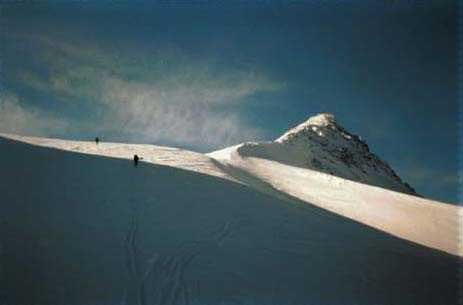 Firnpasset |
Here we leave the skis, and
start up the ridge. There are good steps all the way to the summit, and the
slopes on the sides are not really steep, so we go with the skiing poles.
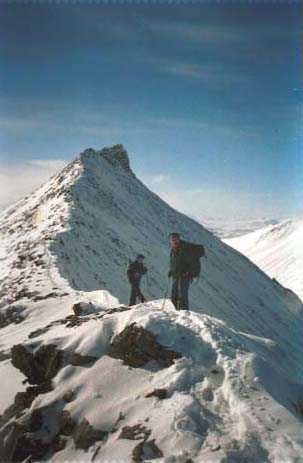 Drakryggen |
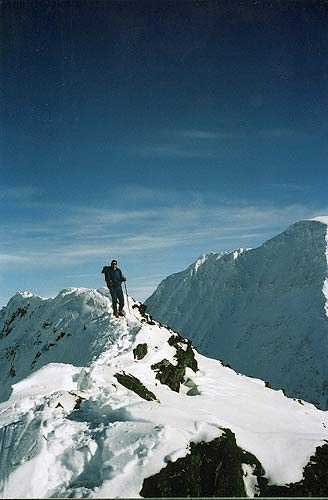 Drakryggen with a part of Kebnepakte in the background. |
Just before the summit there are a few steeper meters. The summit is an excellent panoramic point - one can see Kebnekaise massive with Rabot Glacier to the Southeast and the Kuopertjakka-Kaskasapakte alpine chain to the North. Further, in all directions, it's the endless sea of mountains.
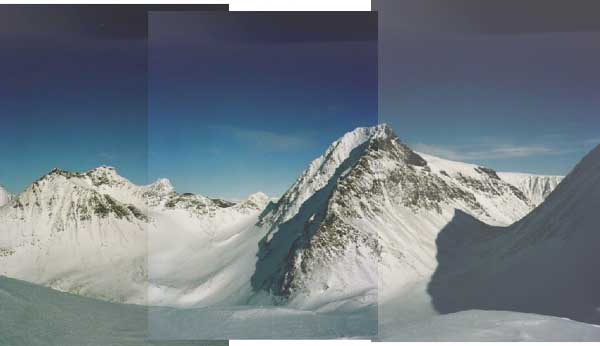 Kuopertjakka-Kaskasapakte chain from Drakryggen's summit. The dominating summit slightly left from the picture's center is Kaskasapakte, with impressive southwest ridge and the snowfield of the west face some recommend as the best route for winter ascent. |
We spend about quarter of an hour on the summit, trying to identify as much
as we can - it might be helpful some other time. On the way down Anton
chooses to take the ice-axe, while we continue using ski-poles. At quarter
to 2 we're lunching on Firnpasset, in sun and comfort. An hour later we take
the skins off on Kebnepakte pass. Well, here's another surprise. At the
first turn I fall, and when examining the ski that went loose, see that the
binding is irreversibly broken. That was the "vintage"
Silvretta-300, and it appears that the metal part holding the front bow, has
thinned to about one mm and now finally gave way. What do they say about not
being rich enough to buy cheap things?
Anyway, I'm surely in no mood to take the loss phylosofically and the
Swedish mountains thus hear another bouquet of Russian curses - trust me,
quite strong they were! Partly gliding, partly stumbling I make my way to
the hut. It's obvious we need to get back to the station. The situation is
also difficult because equipment rental at the station is not exactly cheap…
After certain discussion we decide that Michael (as the handiest) and me (as
the one who talks Swedish and English) are going to ski down to the station
early next morning, to catch up with the guys at Sporten at 8 a.m.
Thursday, March 22nd
The weather is lousy - wind, snow and nearly no visibility during the
first half of the day, clearing up a little in the afternoon, but still
blowing. That is a kind of consolation over the lost day. At 7 a.m. we start
downwards, and come to Sporten's door at 8 sharp. After some research Olof,
the friendly and eager-to-help guide, produces a pair of old skis they
normally use in summer. 350 crowns and I'm the happiest man on earth! To
make our schedule more flexible, we decide to take some more food up to
Tarfala, adding some beers as a surprise for Anton, who faithfully waits for
us, cleaning the hut and filling all reservoirs he can find with the water
he is melting on the stove to safe gas and time later. It still blows quite
strong when we come back to the hut, Anton's skis tied to backpacks. We go
to bed early - an attempt on Kaskasapakte's east ridge is to be made
tomorrow.
Friday, March 23d
We start from the hut at 8.30. It's windy and intermittently cloudy, but
not really bad. At the beginning of the slope towards the Lilietoppen pass
we catch up with the two Swedes - Magnus and Ellen, working at the station
and using their time off duty for climbing. They spent the night at the
research station and intend to try the same route as we. Magnus has climbed
it in descent in summer, so he kind of knows the way, which is, as well as
the fact of being a bigger bunch, rather encouraging.
We leave the skis and start making the steps up. The snow isn't very deep,
but tiresome anyway. We move a little bit faster than Magnus and Ellen,
taking turns in leading.
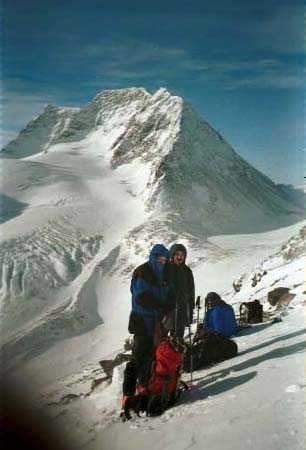 Kebnepakte |
The slope is probably shielded from
strong winds and the snow is therefore soft, so we have to step aside after
about 150 steps, catching the breath and letting the next continue. When we
come up to the saddle, Magnus and Ellen are somewhat behind, so we decide to
circle Lilietoppen and start, not to make the ridge overcrowded. As soon as
we come on Lilietoppen's Southwest slope we feel the wind! It blows
disgustingly and the summit is in the clouds! Our spirits plunging, we turn
back. On the saddle, however, it's nearly quiet and the swedes peacefully
dine in the small snowpit they digged. "We're going to take a
look," - says Magnus. Well then, probably it's not that bad for us
either. And indeed, when we circle Lilietoppen for the second time, the wind
is a bit softer, and the summit can be seen clearly. The whole gang descends
to the saddle between Lilietoppen and Kaskasapakte.
We put the harnesses on, rope ourselves together - and: "It's time to
roll!"
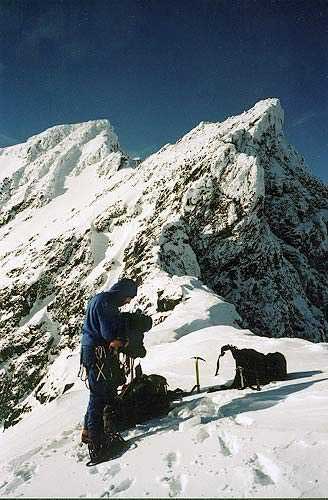 On the saddle where the climbing part starts. I climbed more or less along the right side of the snowpatch that starts at the level of Michael's head. The snowfield just below the summit is what stopped us, being to avalanche dangerous. |
The first part, to the deep saddle just before the pitch, is easy - more or less walking, with the exception of a meter-wide "cut" in the ridge, that we jump across, belaying each other through the ice-axe. Last couple of meters to the small saddle is a little steeper. It takes me some time to choose the way, so Magnus and Ellen are right behind us. We feel bad about probably hindering them and wait a little bit, so they can go first. Just before the "crux ", however, Magnus desides to go back - he's not sure they will make it before dark. I try to persuade him, saying that we can surely dig a cave together, but he is firm. "Well, take a look at us every now and then and thanks for moral support!". Feeling ourselves in the unfamiliar mountains we really needed someone to tell us something reassuring about the route. Magnus says the pitch is one ropelength of Swedish grade 4 climbing. I don't really know what this implies, but it doesn't seem to be very difficult. Indeed, it's about 50-55 degrees steep mixed slope with good and reliable handgrips all the way, even though one must remove the snow first. I make two intermediate belay points along the 50-meter long pitch - one with the piton and the other - a sling on the rock. Some permanent slings are hidden in snow - so says Magnus, but it's not worth it to search. The guys use joumar-ascenders to come along the rope I fix on the large stone just below the ridge (the pitch is slightly to the left and back onto the ridge).
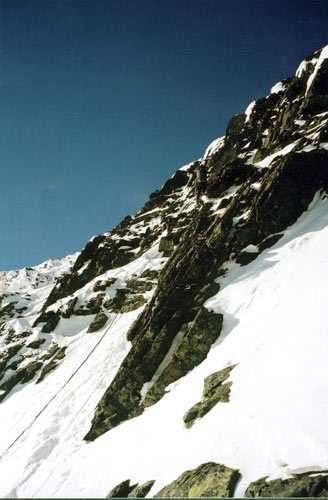 Michael "joumars" up the pitch. |
Next part is traversing the ridge - we go simultaneously. The last step to
the summit, however, proves to be an unpleasant surprise. One needs to cross
a 40 degrees steep snowfield. The snow is above-knee-deep and produces
terrifying sounds at every step. I guess I do understand now what Peter Ask
meant when he wrote about bad snow conditions replying to my e-mail… 50
meters altitude-wise below the summit we turn back - it's too
avalanche-prone. "What the hell - we climbed the crux anyway!"
serves to justify the desicion. One never knows if it wasn't the wind and
the exhaustion - but reflecting on the slope I guess I'd turn back in
Caucasus or Urals as well. The descend is swift, especially since it's
really cold and the ridge is already in the shade. We abseil two halfropes
down the pitch, leaving two slings on the stones. The "cut" in the
ridge is the last difficult step. The eastern "shore" we need to
get to now is about 30 cm higher, so I don't feel a jump is an option, at
least when you go first. Anton belays through the station made of two
ice-axes in snow, standing on it for extra safety. I take the longest
ice-axe we have in the left hand and slowly lean forward to set my weight on
it. Then I set the other tool as far as I can in the snowcovered rock with
my right, hoping it would find something to stop on. It does! Now my body
forms kind of a bridge over the 10 m deep crevasse. I draw myself slowly
holding upon the ice-tools, then make a few steps away from the edge and set
the tool in the snow. Now the guys can use the rope to hold on to. Michael
does it the safest way - with the prussic knot and slowly stepping over the
hole. Anton, however, desides to jump, and does it successfully. Of course,
the risk is only one-two meter fall, but it would be rather uncomfortable in
this weather.
On top of Lilietoppen we catch some last rays of sun - it's really sweet.
Our traces, and the ones of Magnus and Ellen, who came down about three
hours ago, are nearly invisible, but one can feel them under the fresh snow,
and we run down, without stopping to take harnesses and crampons off. At 7
p.m. we're at the hut. It's been a good day!
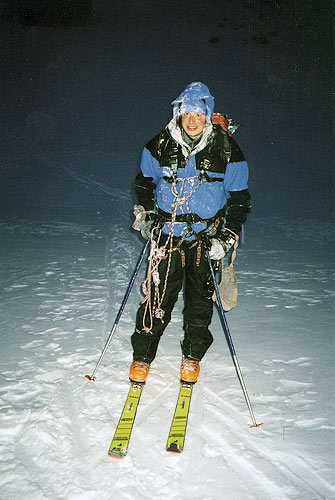 Me immediately after descent, approaching the hut. |
The thermometer shows -18. The cabin keeper has arrived today and views us with a certain surprise: "What have you guys been doing up there?". Anyway, we feel the beers we open immediately are well deserved. No one intends to climb tomorrow - we definitely need some rest and plan to ski without loads.
Saturday, March 24th
We wake up to the bright sun shining into the hut's window and eat a
leisurely breakfast. As was agreed with Walter, the hut keeper, yesterday,
we move our stuff to the main building, which once again surprises us with
all the facilities at the travellers' service in the Swedish mountains.
During the first half of the day we go up to Tarfalapasset and enjoy skiing
down without backpacks. The weather is magnificent - we hope it stays this
way tomorrow.
 The panoramic picture from Tarfala hut. Kebnekaise is seen at far left, behind the Icefall's Glacier. The big rocky thing next to the right is Norra Klippberget. From the center of the picture to the right are Kaskasapakte - Lilietoppen - Kaskasatjakka- Tarfalapasset - Tarfala- tjakka, an extremely rewarding traverse route for better weather. |
After lunch we decide that, since we're not going anywhere, it would be good to build an igloo.
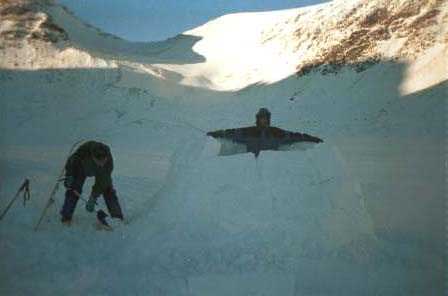 Igloo |
The last time we did it was probably 13-15 years ago, training as teenagers in Hibiny. Ever since then there was never enough time for it in the hectic course of our winter expeditions. That's surely not because we're so disciplined, but because going to the Russian mountains in winter one doesn't have any support for quite long time and has thus to move every day, to make the loads of fuel and food bearable. Sometimes, of course, some supplies can be placed along the way in advance, but you're generally forced to have at least one week's provisions on the rather linear route. So we're glad to revive the skill and discover that it's still there - the igloo is ready in three hours.
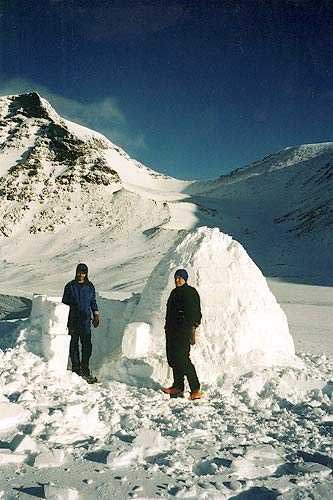 |
We don't intend to sleep in it now, understanding that a night of warmth increases our chances to start early tomorrow, but probably when we come back… While we're absorbed in our architectural efforts, four Finns arrive - fathers in their sixties, sons about our age. They view the process with some mistrust, and seem to be surprised when the job is successfully completed. Later in the hut's kitchen we chat a bit - one of the younger guys is considering Elbrus next summer and we're glad to share what we know. In the evening we pack the things for the traverse of Kebnekaise. Food and gas for one day, snow and climbing gear, sleeping bags, carry-mates and warm clothes - not much, but substantial weight anyway. The rest of our equipment is to wait for us in Tarfala - we plan to come back and climb something else if we have time. Since Keb is one of the primary goals we feel the moment is now - before the weather changes for bad.
Sunday, March 25th
The start today is rather early - 8.00. It's cold, but still and sunny,
so the way up Icefall's Glacier is rather comfortable. In the bright sun we
climb up on skis and skins (the third pair was bought on the station during
our resupply trip there), and it's so still we take windproof jackets off.
The glacier is not steep and the crevasses are surely not a problem in
winter. The icefall itself is to the left and, though small, looks quite
impressive. In about two hours we reach the top of Storglaciaren, where the
slope to Halspasset starts. The snow here is covered by numerous skiers' and
scooters' traces - it's possible to ride the scooter up the Storglaciaren.
The way up to Halspasset is not particularly promising - it's a steep and
rather long snowrun, the natural avalanche collector.
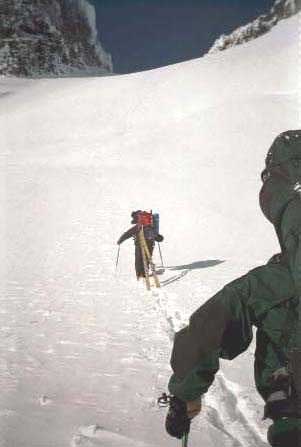 Halspasset |
On top of
that it's exposed to the sun from the very morning and shielded from wind,
so the snow is quite deep. Fortunately though, we don't need to cross it
like on Kaskasapakte, just go up directly.
Trying to move as fast as we can (that is, digging the trail in the snow for
about 20-25 meters and changing then, breathless) we come up in about 40-50
minutes. An expected disappointment - the start of a climb to the Kebnekaise
northridge is in the shade, and it's terribly cold there. A quarter of an
hour needed to put crampons and harnesses on and prepare the rope and we
forget that it was quite hot just a few meters away. The guys put on down
jackets, and prepare to wait till I find my way up. According to Olof, whom
I consulted at the station, it's also grade 4, about two ropelengths, and
there are permanent belay points along the way. Olof added, however, that
the climbing course from the station had to turn back, because they couldn't
find some of the anchors in the ensnowed rock. The first part, the traverse
up and to the left of the ridge itself directly from the saddle, is rather
uncomfortable, and it takes a couple of attempts before I find reliable
grips to make the crucial step. Then it becomes rather easy, and I see one
of the permanent stations with rather worn piece of rope coming from the
snow and disappearing into it a bit lower. The way it is placed suggests
that the climb should probably start not directly from Halspasset, but a
little bit lower on the western side, and that it's probably a bit easier
this way. It is, however only of theoretical interest now.
After an unsuccessful attempt to dig to the anchor the rope is fixed to I
turn it into the belay point fixing my prussic sling upon it and continue
direct upwards. The slope here is a little bit less steep than on
Kaskasapakte, which actually makes it harder in winter conditions. The rock
is covered with a layer of firm snow that is not everywhere thick enough for
the crampons to hold, so instead of holding to reliable rock grips I
"snowdrytool", i.e. hit the slope with icetools' beaks, that cut
through the snow till they find some hole or step in the rock to stop upon.
Since the guys are "around the corner" now I can hardly hear what
they say, and, crying my lungs out, beg for more rope, which is just so
typical… When all the 50 meters are used, I dig in the snow to find
something to make a station on and luckily come upon the large stone, either
part of the rock, or lying flat on it and frosen fast. Station! And after a
short while I see Michael sliding his joumar up with terrifying speed. Next
comes Anton, and then Michael abseils down to get my backpack, while I
gather myself for the next part. That is about the same terrain, a little
bit to the right first, then more or less straight up.
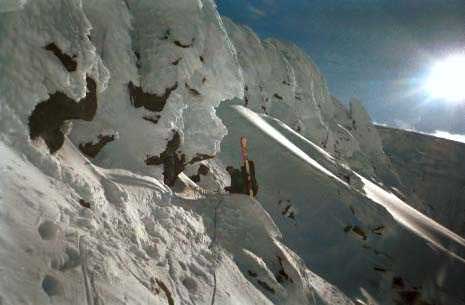 |
Since no
acrobatic jumps are expected, I put on Michaels backpack, with the skis
hanging from it. That proved to be not the wisest desicion, but probably
saved some time anyway.
Along my way I see two more permanent slings and gladly use them. The second
half of the ropelength, however, doesn't have any decent place to put a
sling on or set the stopper in. The 50 meters are just enough to come up to
the place where the snow is deep enough to put the ice-axe into it. I fix
the rope and my own safetyline on it, knee down on the pit the ice-axe is
in, and yell to the guys to come up. It's not without some rather abrupt
motions I immediately feel on my knees that Anton comes up, but he brings
longer ice-axe with him and the station becomes much more secure. From here
it's just a few meters left to the ridge and Anton makes it to the flat
part, securing us through his ice-axe as we both come up simultaneously. The
last part of the climb and all the ridge are in the sunlight, so we have the
luxury of a rest before continuing up the ridge. It's simple walking in
crampons up to the Nordtoppen. Sveriges tak, the ridge between Nordtoppen
and Sydtoppen, is more exposed, so we change the poles for ice-axes and rope
ourselves together once again. Not that it couldn't be done individually,
but since we have the harnesses on and the bags are not really light we feel
safety should be prioritised. The wind is picking up and we don't spend much
time on the Sweden's highest mountain.
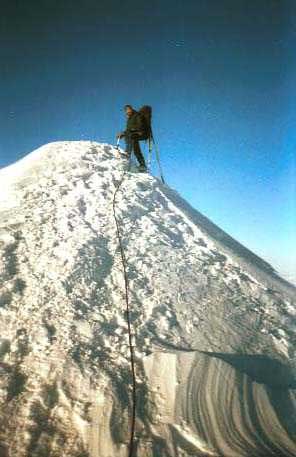 |
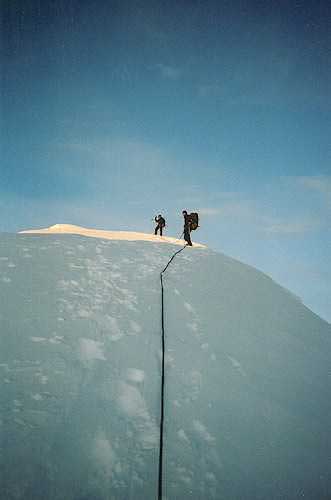 |
A short part on feet, then the rope is packed away, and we put the skis on.
After some 200-300 meters, however, it becomes steeper, so Anton and Michael
take the skis off again. I creep down to toppstugan on skis,
"serpentining", just because I'm tired and lazy and my knees don't
feel it would be quite right to descend walking in the snow. It's about
five, but we don't intend to come down to the station today - we're tired
and the skiing would thus be no fun. And then, of course, it's going to be
much nicer to spend half a day at the station, with wine, sauna and china
plates than just bumping in there at twilight for the same price. It's cold
in the hut, but becomes much better while we cook our dinner and copious
amounts of tea on the gas stove. Three out of four beds are functional - we
sleep well, thanks to fleece underwear and good sleeping bags. We found out
later that the temperature was -22 this day. Thank God it was
sunny!
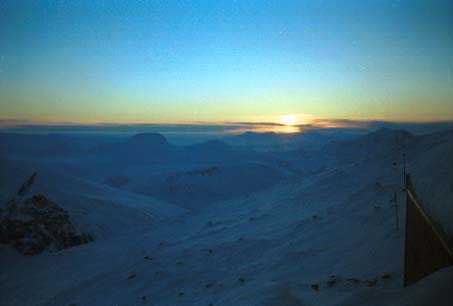 Cold, clear and beautiful. Sunset seen from the toppstugan. |
Monday, March 26th
In the morning the wind blows rather hard. After a lazy breakfast we
descend (this time all three on feet) down the Western route, to the saddle
between Kebne and Vierranvarri, across the latter, and down into the
Kittelbäcken. Here we put on skis again. On our way down we meet some
people ascending from the station, everybody is doubtful if they should
continue in such a wind, and we try to say something encouraging, like
"it's only 11, so you have plenty of time!". It turns out,
however, that transition to summer time has already been made and it's one
hour later. Not that it makes any difference for us… In the Kittelbäcken
it's quiet and sunny. Halfway to the station we meet three girls from the
station's' reception, who gave up climbing Tuolpaguorni because of reported
wind up there and enjoy catching some tan instead. I guess we look rather
awkward, skiing down with our bags of gear, but it feels fine anyway. At two
we sit in the station's kitchen, sipping Moldavian red we fetched from our
storage and devouring a big part of our cheese supply along with it. Calls
to wifes in St.Petersburg and Lund, dinner and sauna constitute the rest of
our recreation day. We meet the Finnish gang once again - two of them have
slept in our igloo last night and found it rather cold - well, it's too big
for two, we explain. The main goals are achieved, even if we had to turn
back within reach of Kaskasapakte. We plan to return to Tarfala and attempt
Kebnepakte's North ridge now. Alternatively - just ski down the glaciers on
Kebne's east side.
Tuesday, March 27th
Late in the morning we start again up the familiar way to Tarfala. It's
windy and intermittenly cloudy, the air is way warmer than last week. Walter
greets us like old friends. He says "Three crazy Russians built this
igloo" was a frequently said frase lately. We catch a glimpse of fame
when the guys from the randonnee course request to be photographed with the
builders. "Shit, we'll have to live up to the image and sleep in
it!". No, it wasn't really that hard, especially since one can still
use the hut's facilities for a small fee. One gets spoiled fast - especially
with all the comfort of Swedish mountain refuges. At about ten we wish those
staying in the hut good night, and, sleeping bags and carry-mates in our
hands, make the 10 meters to the igloo in just the outer shells of our boots
- inner shoes are in the drying room. A quarter of an hour with the gas lamp
and it's warm enough. It's not long before we fall asleep.
Wednesday, March 28th
Complete whiteness meets us when we get out of igloo. It's warm, damp
and windy. No chance we can climb today. Just one day left before we need to
start on our way home our perspectives of further sport achievments become
doubtful. Somewhat puzzled, we sit in the hut's kitchen, talking about
nothing in particular. Then an idea, roughly formulated as "are we
crazy russians or what?" strikes into my mind. Since no time must be
wasted when one is on a rare vacation, why not change the plan and travel to
Lund instead. It's not very difficult to persuade the guys, since they get a
chance to see Stockholm and Kopenhagen, thus turning a merely sports'
journey into also a cultural one. Packing doesn't take much time, and by
lunchtime we're at the mountain station. The forecast sheet on the
reception's wall promises zero temperature and storms for the rest of the
week., which makes us even more convinced we did the right thing. Göran's
nauseatingly vibracious truck delivers us to Nikkaluokta, and 45 minutes
later we start the 21-hour long non-stop to Lund. At 4 p.m. next day I call
Julia, my wife, just from below the house, to come down and take a picture
of a fully packed car and three rather exhausted but happy guys with an
uneven suntan. That's, in general, the finish of the journey, if not for an
early drive to Stockholm three days later, and the ferry-car journey the
guys took from there. The "crazy" part ends here anyway.
Läs mer
Forumdiskussioner
- Miljöpåverkan Tråd för klimatdebatt
- Allmänt om friluftsliv Hällmålningarna i Gaskavre
- Allmänt om friluftsliv Mode utomhus
- Turskidåkning Nån som testat Flexi bindningen?
- Turskidåkning Tur i tält över jul&nyår, snöläget?
- Turskidåkning När är det bra tid att tura i olika delar av fjällkedjan?
- Turskidåkning Torne Träsk till Lappjordhytta -svår men lockande väg in i Norge
- Turskidåkning Paris pulkan / Fjellpulken transporter när man skråar längs





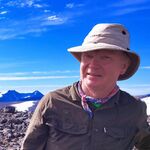
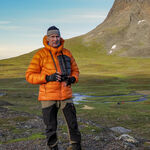
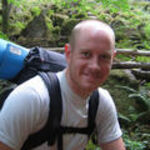

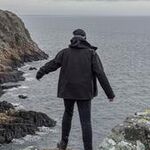
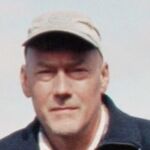
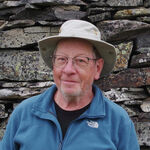
Well written article, like the pictures even though their quality aint the best.